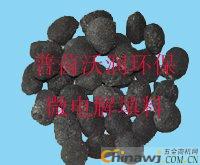When the system becomes overloaded, multiple micro-battery systems are created within the device, generating an electric field in its operational space. The new ecological components [H] and Fe²⺠produced during the treatment process can undergo redox reactions with various substances in the wastewater, such as chromophores or color-enhancing groups. These reactions effectively destroy colored compounds in dye-laden wastewater, even breaking down complex molecular chains to achieve degradation and decolorization. The Fe²⺠formed is further oxidized into Fe³âº, which forms hydrated colloids with strong adsorption and flocculation properties. When alkali is added to adjust the pH, ferrous hydroxide and ferric hydroxide colloids are generated. These colloids have a much higher adsorption capacity compared to those from conventional agents, allowing them to efficiently capture fine particles, metal ions, and organic macromolecules suspended in water. This treatment method combines electrochemical processes, oxidation-reduction reactions, physical adsorption, and flocculation-sedimentation to effectively purify wastewater. It offers advantages such as broad applicability, excellent treatment performance, low cost, ease of operation, and no need for power consumption. The process not only significantly reduces COD and chroma in refractory high-color wastewater but also greatly enhances the biodegradability of the treated water.
Traditionally, micro-electrolytic materials used in the micro-electrolysis process are usually iron filings and activated carbon. These materials require activation with acid or alkali before use. However, they tend to become passivated over time due to the formation of an insulating layer between the iron and carbon, leading to reduced efficiency and eventual failure. This necessitates frequent replacement, increasing both labor and costs while affecting the overall treatment performance and efficiency. Additionally, the limited surface area of traditional micro-electrolytic materials results in longer treatment times, raising the cost per ton of water processed and hindering the widespread adoption of the micro-electrolysis technique.
The application scope of iron-carbon fillers includes dyeing wastewater, coking wastewater, petrochemical wastewater, leather tanning wastewater, papermaking wastewater, wood processing wastewater, electroplating wastewater, printing wastewater, mining wastewater, heavy metal-containing wastewater, and pesticide wastewater. Although this list is not exhaustive, we can confidently say that if your wastewater is suitable for treatment with micro-electrolytic fillers, our products will definitely exceed your expectations.
Weifang Puyinworun Environmental Protection Technology Co., Ltd. warmly welcomes both new and returning customers to visit us. We sincerely hope to collaborate with professionals from all industries to create a clean and beautiful environment, ensuring a bright future with clear waters and blue skies for generations to come.
Weifang Puyinworun Environmental Protection Technology Co., Ltd. is the largest and most successful manufacturer of iron-carbon fillers in China. Our fillers are jointly developed with Sun Yat-sen University and are sintered at 1050 degrees Celsius to form a structural alloy. This advanced technology enables effective removal of high concentrations of organic matter, reducing COD and improving the biodegradability of wastewater while removing color and breaking down complex molecules. The product consists of iron, carbon, activators, and catalytic metals, solving issues of traditional packing materials such as passivation and clogging. Our unique advantages include no binding agents, no passivation, no need for replacement, high strength, and low loss (annual loss less than 15%).
Driven by a commitment to excellence, the company has assembled a team of professionals who maintain long-term technical collaboration with Sun Yat-sen University. With strong technical capabilities and rapid development, the quality, sales volume, and output of our iron-carbon fillers lead the industry, earning widespread praise and trust from users. Many of our projects have been recognized as model cases. The application range includes electroplating wastewater, dyeing and printing wastewater, chemical wastewater, coking wastewater, circuit board wastewater, ammonia nitrogen wastewater, pharmaceutical wastewater, and metal product wastewater.


Balanced Flowmeter,Balanced Flow Meter,Balancing Valve Flow Meter,Throttling Device
Jingsu Huaerwei Science and Technology Group Co.,Ltd , https://www.hewflowmeter.com